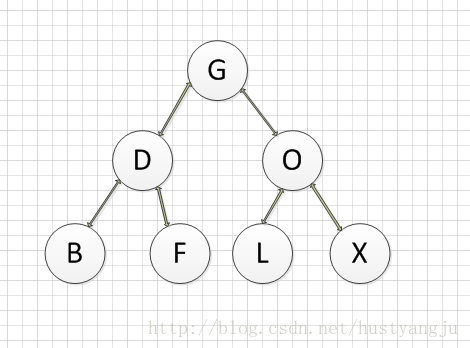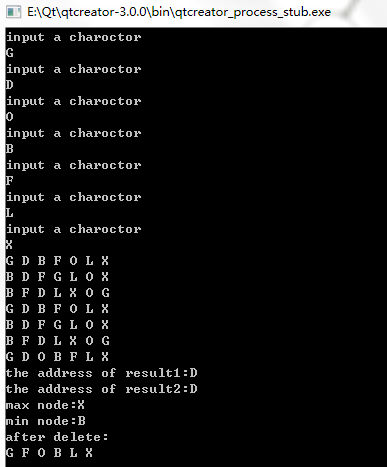读书、思考、写代码!
说明:
(1)这里实现了搜索二叉树的全部常用操作
(2)限于时间和精力,实现的较为粗糙,内存泄露、成员变量访问控制、返回类型、异常安全等没有照顾的到
(3)一切实现的手段都是贴近底层操作,关注原理。以后可能对推倒重来,实现一个完备的接口系统。
/*********************************************
* copyright@hustyangju
* 题目:二叉树接口实现大合集
* 具体:二叉树的创建、插入、最大值、最小值、前中后序递归遍历与非递归遍历、
* 搜索二叉树的递归与非递归搜索、搜素二叉树的删除操作(涉及前驱、后驱、子树移动)
* 分析:按照搜索二叉树的性质,除了删除操作其他的操作相对直接和容易。关于搜索二叉树的删
* 除操作,就是要在删除一个节点后怎么样维护搜索二叉树的性质的问题,较为复杂,实现部分有说明
***********************************************/
#include <iostream>
#include <stack>
#include <queue>
using namespace std;
/*
*创建二叉搜索树结点类型,一个char数据,三个指针(左孩子、右孩子和双亲)
* 双亲指针(parent)在二叉搜索树的插入和删除操作、获取前驱和后继操作中都会用到,二叉树遍历用不到
*/
class binary_tree_node
{
public:
/*全部声明为public,方便直接访问,注意初始化!*/
binary_tree_node(char a):data(a),left_child(NULL),right_child(NULL),parent(NULL){}
~binary_tree_node(){}
char data;
binary_tree_node *left_child;
binary_tree_node *right_child;
binary_tree_node *parent;
};
/*
*创建二叉搜索树类型,数据成员为根结点的指针
* 通过不断插入结点的方法创建二叉搜索树
* 二叉搜索树的遍历方法和普通二叉树的遍历没什么区别
*/
class binary_tree
{
public:
/*自定义构造函数,形参为二叉搜索树的结点数量,注意初始化*/
binary_tree(unsigned int size):root(NULL),_size(size){}
~binary_tree(){}
/*二叉搜索树的创建,调用insert_node()插入结点,按照二叉搜索树的大小特性插入*/
void create_binary_tree();
binary_tree_node* get_root(); //获取根结点
void inorder_tree_walk(binary_tree_node* node);//中序遍历的递归算法
void insert_node(binary_tree_node *node); //通过比较结点关键字段的大小插入结点
void preorder_tree_walk(binary_tree_node* node);//前序遍历的递归算法
void postorder_tree_walk(binary_tree_node* node);//后续遍历的递归算法
void inorder_tree_walk2(binary_tree_node* node);//中序遍历的非递归算法
void preorder_tree_walk2(binary_tree_node* node);//前序遍历的非递归算法
void postorder_tree_walk2(binary_tree_node* node);//后续遍历的非递归算法
void levelorder_tree_walk(binary_tree_node* node);//逐层打印二叉树
/* part II*/
binary_tree_node* search(char a);//搜索一个元素,非递归
binary_tree_node* search2(binary_tree_node* node, char a);//递归搜索一个元素
char max();//找最大元素
char min();//找最小元素
void tree_delete(binary_tree_node *node);
protected:
void visit(binary_tree_node* node);//打印结点
binary_tree_node* tree_successor(binary_tree_node *node);
binary_tree_node* tree_presuccessor(binary_tree_node *node);
void transplant(binary_tree_node *first,binary_tree_node *second);//二叉搜索树内移动子树
private:
binary_tree_node *root;//根结点指针
unsigned int _size;//二叉搜索树的结点数量
};
/*获取根结点*/
binary_tree_node* binary_tree::get_root()
{
return root;
}
/*打印结点关键字*/
void binary_tree::visit(binary_tree_node* node)
{
cout<<node->data<<" ";
}
/*查找一个结点的后驱,分两种情况查找,第二种情况较为抽象,参考《算法导论》164页*/
binary_tree_node* binary_tree::tree_successor(binary_tree_node *node)
{
if(node->right_child!=NULL)//该结点的右子树不为空,右子树的最小值结点即是后驱
{
node=node->right_child;
while(node->left_child!=NULL)
{
node = node->left_child;
}
return node;
}
else//该结点的右子树为空,往上查找第一个比其大的结点,直到遇到通过左子树回溯遇到的结点,这种情况较为抽象
{
binary_tree_node* tmp = node->parent;
while((tmp!=NULL)&&(node==tmp->right_child))
{
node = tmp;
tmp = tmp->parent;
}
return tmp;
}
}
/*查找一个结点的前驱,与查找后驱对称*/
binary_tree_node* binary_tree::tree_presuccessor(binary_tree_node *node)
{
if(node->left_child!=NULL)//该结点的左子树不为空,左子树的最大值结点即是前驱
{
node=node->left_child;
while(node->right_child!=NULL)
{
node=node->right_child;
}
return node;
}
else//左子树为空,往上查找第一个比起小的结点,通过右子树回溯遇到的结点
{
binary_tree_node* tmp = node->parent;
while((tmp!=NULL)&&(node==tmp->left_child))
{
node = tmp;
tmp = tmp->parent;
}
return tmp;
}
}
/*二叉搜索树内移动子树,将second子树替代first*/
void binary_tree::transplant(binary_tree_node *first, binary_tree_node *second)
{
if(first->parent==NULL)
root=second;
else if(first==first->parent->left_child)
first->parent->left_child=second;
else
first->parent->right_child=second;
if(second!=NULL)
second->parent=first->parent;
}
/*根据关键字大小插入新结点
*从根结点开始比较,比根节点小进入左子树,比根节点大进入右子树,逐步往叶子结点方向寻找到新结点的位置
* 再根据关键字大小挂在左边或者右边,设置好三个指针
*/
void binary_tree::insert_node(binary_tree_node* node)
{
binary_tree_node *tmp1 = root;
binary_tree_node *tmp2 = NULL;
while(tmp1!=NULL)
{
tmp2=tmp1;
if(node->data < tmp1->data)
tmp1=tmp1->left_child;
else
tmp1=tmp1->right_child;
}
node->parent=tmp2;
if(tmp2==NULL)
root=node;
else if(node->data < tmp2->data)
tmp2->left_child=node;
else
tmp2->right_child=node;
}
/*
* 每次输入一个字符创建一个结点,再把这个结点插入到二叉搜索树的叶子结点上
* 如果根节点不存在,新结点就设为根节点
*/
void binary_tree::create_binary_tree()
{
for(unsigned int i=0;i<_size;++i)
{
cout<<"input a charoctor"<<endl;
char data;
cin>>data;
binary_tree_node *node = new binary_tree_node(data);
insert_node(node);
}
}
/*中序遍历的递归算法
* 形参为根节点
* 中序遍历的顺序为(左子树->根节点->右子树)
*/
void binary_tree::inorder_tree_walk(binary_tree_node* node)
{
if(node!=NULL)
{
inorder_tree_walk(node->left_child);
visit(node);
inorder_tree_walk(node->right_child);
}
}
/*中序遍历的非递归算法
* 形参为根节点
* 采用栈存储作为中序遍历的非递归方法,首先根节点进栈,先遍历左子树直到左子树为空,出栈并打印该节点关键字。再去访问出栈结点的右子树
* 右子树不为空,继续:该节点进栈->遍历左子树->出栈并打印->右结点
*/
void binary_tree::inorder_tree_walk2(binary_tree_node* node)
{
stack<binary_tree_node*> _stack;
binary_tree_node *tmp = node;
while(NULL!=tmp || !_stack.empty())//结点不为空或者栈不空,可以继续遍历
{
if(NULL!=tmp)
{
_stack.push(tmp);//结点进栈
tmp=tmp->left_child;//遍历左子树,直到左子树为空
}
else
{
tmp=_stack.top();//左子树遍到叶子结点,取出栈顶结点并打印,访问右孩子
visit(tmp);//如果右孩子不为空,重复上述步骤,先左再根后右;如果右孩子为空,再出栈一个结点,接着访问右孩子
_stack.pop();
tmp=tmp->right_child;
}
}
}
/*前序遍历的递归算法
* 形参为根节点
* 前序遍历的顺序为(根节点->左子树->右子树)
*/
void binary_tree::preorder_tree_walk(binary_tree_node* node)
{
if(node!=NULL)
{
visit(node);
preorder_tree_walk(node->left_child);
preorder_tree_walk(node->right_child);
}
}
/*
* 前序遍历的非递归算法
* 形参为根结点
* 采用栈结构,根结点进栈,遍历左子树,结点进栈立即打印关键字
* 直到左子树为空,出栈的同时,去访问其右孩子。如果右孩子不为空,重复上述步骤;如果右孩子为空,继续出栈
*
*/
void binary_tree::preorder_tree_walk2(binary_tree_node* node)
{
stack<binary_tree_node*> _stack;
binary_tree_node *tmp = node;
while(NULL!=tmp || !_stack.empty())
{
if(NULL!=tmp)
{
_stack.push(tmp);
visit(tmp);
tmp=tmp->left_child;
}
else
{ tmp=_stack.top();
_stack.pop();
tmp=tmp->right_child;
}
}
}
/*
* 后续遍历的递归算法
* 左子树->右子树->根结点
*/
void binary_tree::postorder_tree_walk(binary_tree_node* node)
{
if(node!=NULL)
{
postorder_tree_walk(node->left_child);
postorder_tree_walk(node->right_child);
visit(node);
}
}
/*
*后续遍历的非递归算法
* 后续遍历的非递归算法比较复杂,这里采用两个栈的思路
* 后续:左子树->右子树->根节点,先在第一个栈里遍历 根结点->右子树->左子树,用第二个栈颠倒次序
*/
void binary_tree::postorder_tree_walk2(binary_tree_node* node)
{
stack<binary_tree_node*> _stack;
stack<binary_tree_node*> output;
binary_tree_node *tmp = node;
_stack.push(tmp);
while(!_stack.empty())
{
tmp=_stack.top();
output.push(tmp);//栈一出栈,栈二进栈
_stack.pop();
if(NULL!=tmp->left_child)//先left后right不能颠倒
_stack.push(tmp->left_child);
if(NULL!=tmp->right_child)
_stack.push(tmp->right_child);
}
while(!output.empty())
{
binary_tree_node *tmp2 = output.top();
visit(tmp2);
output.pop();
}
}
/*
* 逐层打印二叉树,每层不间隔,如果每层间隔,要另外设计算法
* 基于Queue来实现,也就是广度优先搜索(BFS)的思想
*/
void binary_tree::levelorder_tree_walk(binary_tree_node* node)
{
queue<binary_tree_node*> _queue;
_queue.push(node);
while(!_queue.empty())
{
binary_tree_node *tmp = _queue.front();
visit(tmp);
_queue.pop();
if(tmp->left_child!=NULL)
_queue.push(tmp->left_child);
if(tmp->right_child!=NULL)
_queue.push(tmp->right_child);
}
}
/*
* 搜索元素
* 非递归
*/
binary_tree_node* binary_tree::search(char a)
{
if(root==NULL)
return NULL;
else
{
binary_tree_node *tmp = root;
while((tmp!=NULL)&&(tmp->data)!=a)
{
if(a<tmp->data)
tmp=tmp->left_child;
else
tmp=tmp->right_child;
}
return tmp;
}
}
/*
* 递归搜索一个元素
*/
binary_tree_node* binary_tree::search2(binary_tree_node* node, char a)
{
binary_tree_node *tmp = node;
if((tmp->data==a)||(node==NULL))
return node;
else
{ if(a<tmp->data)
return search2(tmp->left_child, a);
else
return search2(tmp->right_child, a);
}
}
/* 找最大元素*/
char binary_tree::max()
{
binary_tree_node* tmp = root;
while(tmp->right_child!=NULL)
{
tmp=tmp->right_child;
}
return tmp->data;
}
/*找最小元素*/
char binary_tree::min()
{
binary_tree_node* tmp = root;
while(tmp->left_child!=NULL)
{
tmp=tmp->left_child;
}
return tmp->data;
}
/*********************************************************************************
* 在二叉搜索树中删除一个结点1.被删除节点没有子树的情况,直接删除,并修改对应父节点的指针为空。
*2.对于只有一个子树的情况,考虑将其子树作为其父节点的子树,关于是左还是右,根据被删除的节点确定。
*3.最复杂的是有两个子数的情况,可以考虑两种方法,都是同样的思想:用被删除节点A的左子树的最右节点
*或者A的右子树的最左节点作为替代A的节点,并修改相应的最左或最右节点的父节点的指针,修改方法类似2
*********************************************************************************/
void binary_tree::tree_delete(binary_tree_node *node)
{
if(node->left_child==NULL)//无左子树,直接用右子树替代即可
transplant(node,node->right_child);
else if(node->right_child==NULL)//无右子树,直接用左子树替代
transplant(node,node->left_child);
else
{
binary_tree_node *tmp=node->right_child;
while(tmp->left_child!=NULL)
tmp=tmp->left_child;
if(tmp->parent!=node)
{
transplant(node,tmp);
tmp->right_child=node->right_child;
tmp->right_child->parent=tmp;
}
transplant(node,tmp);
tmp->left_child=node->left_child;
tmp->left_child->parent=tmp;
}
}
int main()
{
binary_tree btree(7);
btree.create_binary_tree();
binary_tree_node *root = btree.get_root();
btree.preorder_tree_walk(root);
cout<<endl;
btree.inorder_tree_walk(root);
cout<<endl;
btree.postorder_tree_walk(root);
cout<<endl;
btree.preorder_tree_walk2(root);
cout<<endl;
btree.inorder_tree_walk2(root);
cout<<endl;
btree.postorder_tree_walk2(root);
cout<<endl;
btree.levelorder_tree_walk(root);
cout<<endl;
binary_tree_node *result1=btree.search('D');
cout<<"the address of result1:"<<result1->data<<endl;
binary_tree_node *result2=btree.search2(root, 'D');
cout<<"the address of result2:"<<result2->data<<endl;
cout<<"max node:"<<btree.max()<<endl;
cout<<"min node:"<<btree.min()<<endl;
btree.tree_delete(result1);
cout<<"after delete: "<<endl;
btree.levelorder_tree_walk(root);
}
测试搜索二叉树:
测试结果:
























 1829
1829











 被折叠的 条评论
为什么被折叠?
被折叠的 条评论
为什么被折叠?








